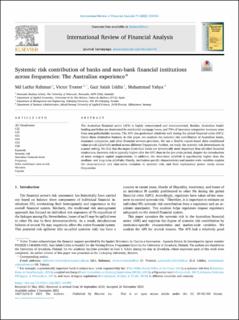Systemic risk contribution of banks and non-bank financial institutions across frequencies: The Australian experience
Peer reviewed, Journal article
Published version
Permanent lenke
https://hdl.handle.net/11250/3037174Utgivelsesdato
2021Metadata
Vis full innførselSamlinger
Originalversjon
10.1016/j.irfa.2021.101992Sammendrag
The Australian financial sector (AFS) is highly concentrated and interconnected. Besides, Australian banks' lending portfolios are dominated by residential mortgage loans, and 70% of insurance companies' revenues arise from non-policyholder sources. The AFS also performed relatively well during the global financial crisis (GFC). Given these distinctive features, in this paper, we examine the systemic risk contribution of Australian banks, insurance companies, and other financial services providers. We use a flexible copula-based delta conditional value-at-risk (ΔCoVaR) method across different frequencies. Further, we study the systemic risk determinants in a panel setting. We find that the major Australian banks are systemically more important than all other financial institutions. Systemic risk is typically higher after the GFC than in the pre-crisis period, despite the introduction of more stringent capital requirements. In addition, the short-term ΔCoVaR is significantly higher than the medium- and long-term ΔCoVaRs. Finally, institution-specific characteristics and market-wide variables explain the cross-sectional and time-series variation in systemic risk, and their explanatory power varies across frequencies.

